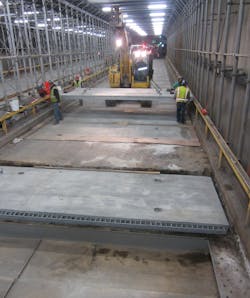All roadway and bridge construction or rehabilitation performed within New York City has the potential to create a traffic gridlock nightmare. This is especially true when the work being performed is in very close proximity to a major arterial route linking Manhattan to an adjacent borough or the neighboring state of New Jersey. Such is the case when the bridge deck on the New York Expressway/Dyer Avenue needed to be replaced. The bridge limits are bound by West 31st and 33rd Streets to the south and north and lie between 9th and 10th Avenues to the east and west. The bridge, owned and maintained by the Port Authority of New York and New Jersey (PANYNJ), crosses the Long Island Railroad (LIRR) tracks between the West Side Yard and Penn Station, and is a direct link to the Lincoln Tunnel that services over 100,000 vehicles per day.
Due to the strategic importance of the structure, full closure to perform the work was not an option and due to the narrow width, neither was staged construction. PANYNJ permitted weeknight closures between 10 p.m. and 5 a.m. the following morning to remove and replace the nearly 20,000 sq ft of bridge deck. The work timeframe restrictions limited deck type solutions to precast options, and further limitations were imposed to maintain the existing overall deck thickness of 7.5 in., which includes a 1.5-in. asphalt concrete overlay.
This design-build challenge was awarded to John Civetta & Sons headquartered in Bronx, NY partnered with Stantec in New York City. Together, they worked with BGFMA-certified fabricating member L.B. Foster to arrive at a solution using 4.25-in. main bar full-depth grid reinforced concrete panels with a 1.75-in. overfill. “Of the available options, only grid-reinforced concrete met all of the design requirements and allowed for overnight installation,” said Stantec engineer Christian Wiederholz, P.E. He added that “because of the tight construction window and the minimum closure pour concrete strength requirement, there would be times when the closure pour could not be made, so we needed to make sure that the deck panels installed in a temporary condition could handle the traffic.” Panels were designed and fabricated to simply span between existing floor beams spaced at approximately 8 ft and match the curb-to-curb width of 22 ft. Timber blocking between panels bridged the gap for temporary support.
Panels with main bar direction shorter than the cross bar direction would normally present lifting and handling challenges. Furthermore, scaffolding for Brookfield Property Partners L.P. development enclosed the site restricting headroom and panel-lifting options. By taking advantage of the inherent, nearly isotropic nature of the 4.25-in. fully filled system, coupled with some additional reinforcement and Dayton Superior Swift Lift System, these obstacles were averted. In total, 118 panels were set, bringing the project to completion in May of this year.



